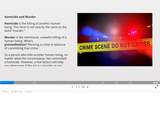
Homicide and Murder Slideshow
- Subject:
- Career and Technical Education
- Criminal Justice
- Material Type:
- Interactive
- Provider:
- Michigan Virtual
- Date Added:
- 07/29/2019

Homicide and Murder Slideshow

On field, students have to image a given asteroid on two consecutive nights, producing two sets of images obtained over 10-15 minutes, each set separated by about 4-5 hours. In class, students have to process the images in order to measure the observed diurnal parallax and then determine the corresponding asteroid distance.
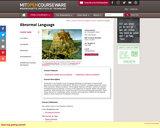
Introduction to the linguistic study of language pathology, concentrating on experimental approaches and theoretical explanations. Discussion of Specific Language Impairment, autism, Down syndrome, Williams syndrome, normal aging, Parkinson's disease, Alzheimer's disease, hemispherectomy and aphasia. Focuses on the comparison of linguistic abilities among these syndromes, while drawing clear comparisons with first and second language acquisition. Topics include the lexicon, morphology, syntax, semantics and pragmatics. Relates the lost linguistic abilities in these syndromes to properties of the brain.
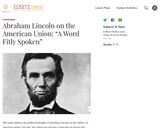
By examining Lincoln's three most famous speeches the Gettysburg Address and the First and Second Inaugural Addresses in addition to a little known fragment on the Constitution, union, and liberty, students trace what these documents say regarding the significance of union to the prospects for American self-government.
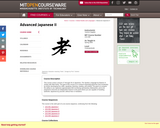
Continuation of 21F.505. Further development of reading, writing, and oral communication skills. Extension of advanced grammar and further enhancement of advanced vocabulary. Variety of cultural elements studied through readings, video, and discussion. Lab work required. This course covers Lessons 27 through 30 of Japanese: The Spoken Language by Eleanor H. Jordan with Mari Noda. The goal of the course is to continue expanding grammar and vocabulary by further developing four skills: speaking, listening, reading, and writing. The goal is to acquire the ability to use Japanese appropriately with increasing spontaneity emphasized, and to be prepared to become an independent learner to the point where you are capable of handling authentic Japanese by yourself, without fear or hesitation.
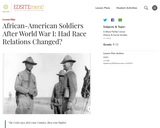
In this lesson, students view archival photographs, combine their efforts to comb through a database of more than 2,000 archival newspaper accounts about race relations in the United States, and read newspaper articles written from different points of view about post-war riots in Chicago.
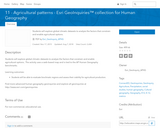
Students will explore global climatic datasets to analyze the factors that constrain and enable agricultural options.
GeoInquiries are designed to be fast and easy-to-use instructional resources that incorporate advanced web mapping technology. Each 15-minute activity in a collection is intended to be presented by the instructor from a single computer/projector classroom arrangement. No installation, fees, or logins are necessary to use these materials and software.
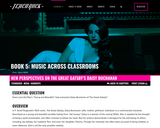
In this lesson, students will explore these questions, comparing Lana Del Rey's "Young and Beautiful" with chapters 1-7 of The Great Gatsby to form their own characterization of Daisy. Students will view the music video for "Young and Beautiful" and analyze advertisements and headlines from 1918-1922 to consider the potential influence of cultural values and gender expectations on women like Daisy. Finally, using excerpts from the novel, the song, and the advertisements, students will work in groups to create an identity chart for Daisy.
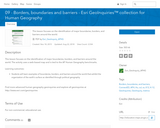
This lesson focuses on the identification of major boundaries, borders, and barriers around the world.

A citizen is someone who is entitled to the legal rights granted by a state, and who is obligated to obey its laws and to fulfill certain duties. Living in the United States does not mean that someone is automatically a citizen. Permanent residents, people who have been lawfully admitted to the United States, are also granted certain legal rights and protections even if they are not citizens. For example, residents can live and work anywhere in the United States, attend public schools, join our armed forces and can also qualify for some Social Security benefits as well. Typically, people who are granted permanent resident status are immigrants who are related by birth or marriage to U.S. citizens or possess important job skills needed in the United States. Unlike citizens, permanent residents may not be able to hold public office or vote in elections. Why should someone consider becoming a citizen if they are not? Check out a list of all of the privileges of citizenship in the United States.

In a letter written to James Madison in 1797, Thomas Jefferson wrote, “The principle of the Constitution is that of a separation of legislative, Executive and Judiciary functions, except in cases specified. If this principle be not expressed in direct terms, it is clearly the spirit of the Constitution…” The separation of powers was one of the fundamental principles of the Constitution’s Framers. The Legislative Branch is sometimes referred as the “people’s branch” since the Founders believed and intended the legislative branch to closely reflect the will of the citizens.
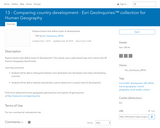
Explore factors that define levels of development.
GeoInquiries are designed to be fast and easy-to-use instructional resources that incorporate advanced web mapping technology. Each 15-minute activity in a collection is intended to be presented by the instructor from a single computer/projector classroom arrangement. No installation, fees, or logins are necessary to use these materials and software.
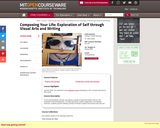
In this interdisciplinary seminar, we explore a variety of visual and written tools for self exploration and self expression. Through discussion, written assignments, and directed exercises, students practice utilizing a variety of media to explore and express who they are.

EL Education does not provide a discrete character education program because we believe that character is not separate from scholarship: character education happens all day long. Explicit focus on character, reflection on character, and critique of character is present in every part of school, whether students are in hallways or in classes. School leaders and staff model positive character in all settings, in front of students and apart from students. Schools embrace the Structure of Crew and the Spirit of Crew: everyone thinking and working to help others in a team approach all day long.
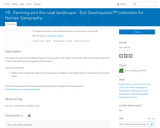
This activity focuses on the different types of land use found in rural landscapes.
GeoInquiries are designed to be fast and easy-to-use instructional resources that incorporate advanced web mapping technology. Each 15-minute activity in a collection is intended to be presented by the instructor from a single computer/projector classroom arrangement. No installation, fees, or logins are necessary to use these materials and software.

GIST is a strategy to help students write brief, accurate, and complete summaries of material they read. In this lesson students work together summarizing larger and larger portions of text, but keeping their summaries at 25 words or fewer. Students will be able to summarize portions of informational or literary text. Students will be able to work in small groups to think critically about and discuss text.

Students will explore hybridization, selective breeding and genetic engineering through a jigsaw approach. Then they will go through a series of articles that help them formulate their own opinions about genetic manipulation. Lastly, they will debate the merits of genetic manipulation as a class.

This is the story of how Les Paul created the world's first solid-body electric guitar, countless other inventions that changed modern music, and one truly epic career in rock and roll. How to make a microphone? A broomstick, a cinderblock, a telephone, a radio. How to make an electric guitar? A record player's arm, a speaker, some tape. How to make a legendary inventor? A few tools, a lot of curiosity, and an endless faith in what is possible, this unforgettable biography will resonate with inventive readers young and old.
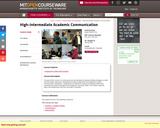
The goal of this course is to review grammar and develop vocabulary building strategies to refine oral and written expression. Speaking and writing assignments are designed to expand communicative competence. Assignments are based on models and materials drawn from contemporary media (newspapers and magazines, television, web). The models, materials, topics and assignments vary from semester to semester.
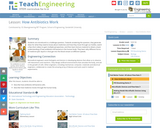
Students are introduced to a challenge question. Towards answering the question, they generate ideas for what they need to know about medicines and how they move through our bodies, watch a few short videos to gain multiple perspectives, and then learn lecture material to obtain a basic understanding of how antibiotics kill bacteria in the human body. They learn why different forms of medicine (pill, liquid or shot) get into the blood stream at different speeds.